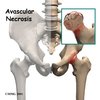Total hip replacement/ arthroplasty complications Flashcards
what can hip dislocation lead to?
circulatory and nerve damage. (avascular necrosis)

S/S
of hip dislocation?
- shortening of leg
- abnormal rotation
- unable to extremity
- pain
what are the 4 complications that can happen with hip replacement?
1- dislocation
2- infection
3- avascular necrosis
4- immobility problems
why does the doc always put them on prophylactic antibiotics?
to prevent infections (that’s why if they have any drains or foley, they need to be removed ASAP!)
____ Is tissue death due to poor circulation.
avascular necrosis… the area is dying because there is no blood supply.

the best exercises after a hip replacement is__
- walking
- swimming
- rock in a rocking chair (for really old people)
avoid all these things:
- low____
- traveling ____ distances
- sitting more than ___ minutes
- lifting____objects
- excessive___ or twisting
- ____ climbing
- low chairs
- traveling long distances
- sitting more than 30 minutes
- lifting heavy objects
- excessive bending or twisting
- stair climbing
what are we suppose to check in CPM (continuous passive motion) machines?
the angle of the flexion it’s set on.
we don’t want the hip to flex too much because it can ruin the surgery.
what must we do first with the use of the CPM?
give pain meds

